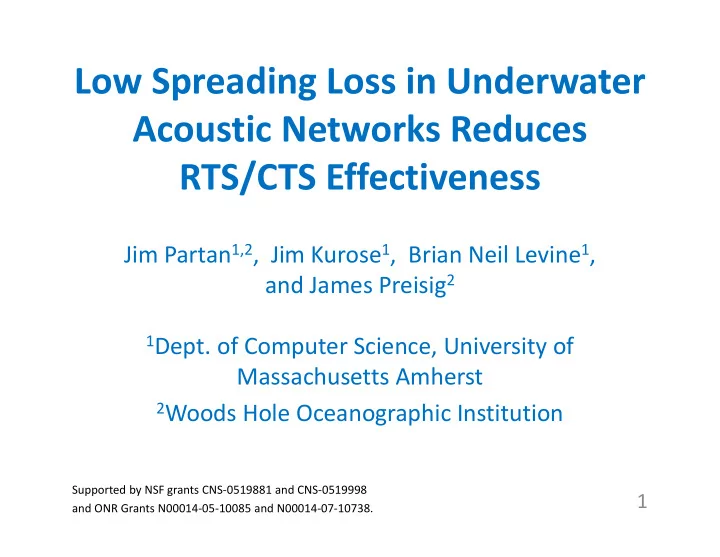

Low Spreading Loss in Underwater Acoustic Networks Reduces RTS/CTS Effectiveness Jim Partan 1,2 , Jim Kurose 1 , Brian Neil Levine 1 , and James Preisig 2 1 Dept. of Computer Science, University of Massachusetts Amherst 2 Woods Hole Oceanographic Institution Supported by NSF grants CNS ‐ 0519881 and CNS ‐ 0519998 1 and ONR Grants N00014 ‐ 05 ‐ 10085 and N00014 ‐ 07 ‐ 10738.
Motivation • Analyze effectiveness of collision ‐ avoidance MAC protocols. • Effectiveness is independent of propagation delay; depends upon spreading loss, absorption loss, and ambient noise. • Long ‐ range interference is fundamentally a network effect, rather than a point ‐ to ‐ point communication effect. • Spreading loss often larger than absorption loss, and also less ‐ well characterized. 2
Approach • MACA ‐ based protocols (RTS/CTS/DATA) are common for RF ad ‐ hoc multihop networks. Despite propagation delay penalties, also proposed for some UAN scenarios. • Primarily Theoretical Analysis – Significantly extended previous radio ‐ based analysis to underwater acoustic channel model • Model Assumptions: – For tractability: circular transmission range, dense and uniform node distribution, high offered load, isovelocity waveguides. – Fixed transmit power, single ‐ band modems. 3
Simple Multipath Spreading Models Model: Received Energy scales with range as � � � k: spreading exponent r: range Deep Water: Shallow Water: Radio Pathloss: Refraction Reflections Two ‐ Ray Ground Reflection Model k ≈ 1.5 k ≈ 1.5 k ≈ 4 (1 < k < 2) ( 1 < k < 2) 4 (2 < k < 6)
Xu et al. 802.11 RTS/CTS Effectiveness � �� : Maximum transmission range of packet (RTS/CTS coverage). • Define � � as the minimum allowable range to an interferer. • Any interferers closer than � � can disrupt detection at receiver. • If � � � � �� , all potential interferers suppressed (a). • If � � � � �� , some potential interferers unsuppressed (b,c). • • Measure of RTS/CTS Effectiveness: � ���/��� � Area� Interferers ∩ RTS/CTS� Area�Interferers� 5
Xu et al. 802.11 RTS/CTS Effectiveness: Collision avoidance requires detection of RTS/CTS packets: (Detection Threshold) Ignore noise, use spreading exponent , transmitter/receiver separated by , interferer/receiver separated by : � � ���� � ���� � ��� � ���� � At equality, , solve for minimum allowable range to interferer: � � � � Define interference range ratio, , such that � � 6
RTS/CTS Effectiveness ( Spreading Only ) � and � ���/��� depend strongly upon detection threshold! 7
Extend Xu et al. to UAN Channel Model • Spreading – both “practical” and “mixed ‐ exponent” models • Absorption (frequency ‐ dependent) • Ambient Noise (frequency ‐ dependent) • Propagation Delay does not enter analysis – primary effect considered in most UAN work • (f,d) is the fundamental quantity: – Can isolate channel effects (spreading, absorption, noise) – Use physical reasoning to get approximate analytic expressions 8
: Spreading, absorption, noise � = 1.5 9
: Spreading, absorption, noise � = 1.5 10
Hypothesized “Mixed ‐ Exponent” Spreading Model • “Practical” spreading model (k=1.5) was intended for first ‐ pass point ‐ to ‐ point acoustic systems design. • Spreading model not a focus of point ‐ to ‐ point acoustic communications, but is important to determine long ‐ range interference in networks. • Want to maintain simple exponent ‐ based model, but incorporate differences between signal processing of packet detection and interference. 11
Packet Detection Multipath Channel During packet detection: • No channel estimate yet – cannot combine arrivals • Detector is ideally low ‐ power (hence low ‐ complexity), often uses a matched ‐ filter detector (e.g. Micromodem) Modeled Detector uses energy from ONE multipath arrival; spreads approximately spherically. 12
Interference and Hypothesized Spreading Model Multipath Channel For interfering packets: • Packets below detection threshold are not detected. • Interference energy is incoherent sum from ALL arrivals • Spreads spherically until transition range, then cylindrically • Transition range is a small multiple of the waterdepth 13
: Spreading, absorption, noise ��� = 1.0 ��� = 2.0 14
: Spreading, absorption, noise ��� = 1.0 ��� = 2.0 15
Unsuppressed Interferers ��� = 1.0 � = 1.5 ��� = 2.0 16
Potential Spatial Reuse Improvements • With single ‐ band, fixed transmit power modem, MAC protocol modifications could potentially reduce collisions, but not increase spatial reuse. • Spatial Reuse improvements need to be implemented in the modem at the physical layer: – PWM power amplifier for efficient transmit power control. – Lower detection threshold to reduce gamma. – Variable signaling and coding for longer ‐ range detection of control packets, in particular CTS packet (interference is at the receiver). – Frequency agility to control propagation range of packets • Routing Table could avoid long links 17
Conclusions • Extended previous RF work on RTS/CTS effectiveness to UANs. • With the “practical spreading” (k=1.5) model, RTS/CTS effectiveness in UANs is comparable to that in radio, aside from propagation delay issues. • With hypothesized “mixed ‐ exponent” spreading model, RTS/CTS effectiveness can be very low in UANs. • Spreading model and detector make a difference in determining UAN performance! • MAC protocol changes can reduce collisions, but not improve spatial reuse – need physical layer solutions. 18
19
SNR (dB) = (Transmit Power) – (Absorption Loss + Spreading Loss) – (Noise Power) 20
: Spreading, absorption, noise � = 1.5 21
: Spreading, absorption, noise � = 1.5 22
: Spreading, absorption, noise ��� = 1.0 ��� = 2.0 23
: Spreading, absorption, noise ��� = 1.0 ��� = 2.0 24
UAN Operating Regime 25
Validated Network Simulations against Numerical Results • Added UAN physical channel to OMNET++/Castalia simulator • Measured interference range, calculated gamma 26
Recommend
More recommend